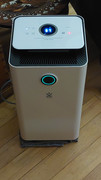cojmh wrote: ↑Sat Oct 05, 2024 11:19 pm
I have done quite a bit of digging into MVHR (Mechanical Ventilation Heat Recovery) and the ducting is the main issue with retrofitting (i.e. getting it to where it needs to go)
Typically you need a balanced in and out flow - from what you have described you have all out flowing points.
From what I have read you have outflow from all damp areas (kitchen, bathrooms, utility rooms) and inflow to dry areas (bedrooms, living room, dining room) and for a centralised system there is quite a bit of balancing to do.
As our new wet room is not on an outside wall we are installing a small standalone unit that has an out flow from the bathroom through a heat exchanger and an inflow that vents into the bedroom.
There are companies out there that will design a system for free from floor plans - based on you buying the equipment from them.
It is quite a big task from what I have seen so far. I don't know about using the kitchen hood extractor.
We have a whole-house MVHR system just for the first floor which was designed by Villavent from our floor plans. They did a materials takeoff from that for all the ductwork and connections. IIRC they are based in Norway but now called SystemAir UK. Our loft is full of 6 in ducting for the main runs and 4 in for the individual drops.
They do not recommend connecting a cooker hood (or tumble dryer) bc of the grease and fluff, but we do have an self-closing (fire) extract point in the kitchen above the AGA. We cut DIY filters out of fire-retardant BAF sheet (upholstery wadding) to collect the grease from the kitchen and towel fluff from the bathrooms, they need changing every 3 and 6 months respectively and keep the duct work and heat exchanger nice and clean. There are then supply points in all the bedrooms.
We also had a damp bedroom wall which we dry-lined with 50mm of sheep's wool insulation and a 50mm cavity which is vented from the room at the bottom and has an extract vent to the MVHR at the top, this keeps the wall free of damp and works well.
Its operation is barely noticeable on Normal fan speed and even quieter on Low. Have modified the controls so that fan speed is increased by one step whenever any of the bathroom lights is switched on with 8 mins over-run.
I have no idea of the efficiency gains but the primary driver was the need to sort out the damp wall and the previous bathroom extractor fans which all vented into the loft space not the outside(!)
